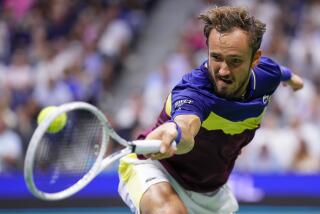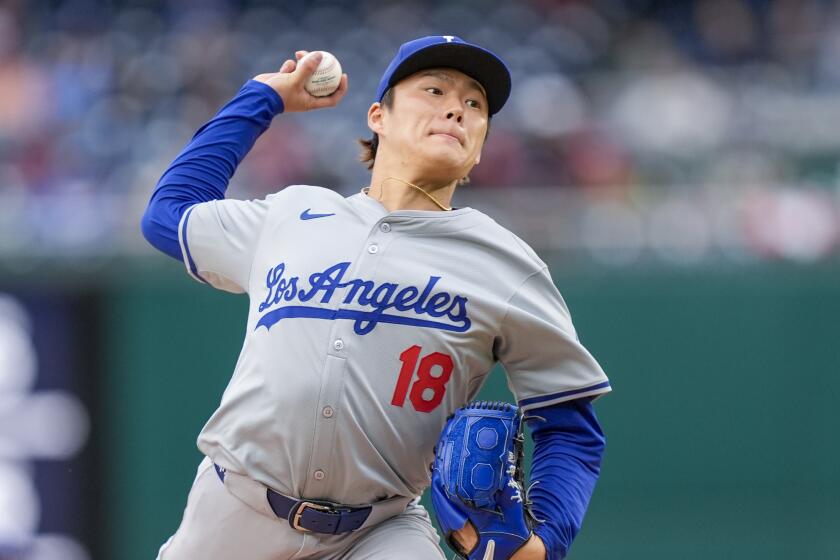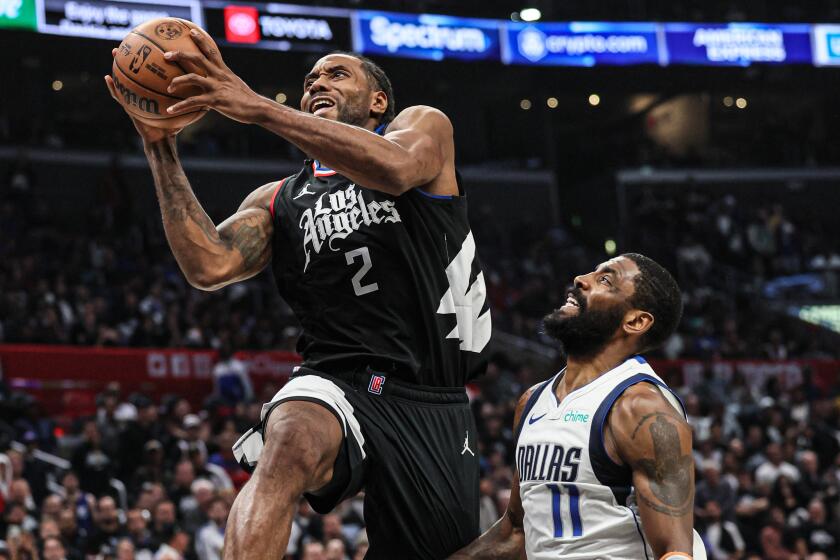Column: If Jack Sock is future of U.S. men’s tennis, it could be a long wait

We trekked out to the U.S. Open’s venerable Grandstand Court on Tuesday on a mission of promise.
Young Jack Sock, up-and-coming U.S. tennis player, was playing his first-round match.
The Grandstand is special. For years, it has been an appendage to Louis Armstrong Stadium, even before Armstrong became the second main court after they built the huge Arthur Ashe Stadium.
It is attached to one side of Armstrong, kind of like a backpack. The crowds are smaller, the chance for shade better and the viewing as up-close-and-personal as you’ll get for big matches. Sadly, after this tournament, they will tear it down for newer, flashier real estate.
This was to be slightly more than a casual viewing mission.
We have written several stories over the past months, with affirmation from puzzled and even angry U.S. officials, that pointed to deficiencies in U.S. men’s tennis results. Their failures have become a given. The only real stat needed: the last U.S. man to win a major tournament was Andy Roddick at the U.S. Open.
In 2003.
If none win here — and the chances of that are a lottery-ticket purchase — it will mean that U.S. men have failed in 44 consecutive majors.
It was time to think positive, to preview possible good things to come. Sock, we were told, has all the tools to bring those.
We had had an earlier glimpse of it. We saw Sock and partner Vasek Pospisil of Canada win an incredible Wimbledon doubles final this year against Bob and Mike Bryan.
It was one of those magical tennis moments. The women’s final had preceded the men’s doubles final and, with Petra Kvitova’s runaway victory having taken less than an hour, the crowd was craving more. That’s exactly what it got. Things got a bit rowdy at Wimbledon, as the match swayed back and forth dramatically.
Sock got the final word.
On match point, he hit a forehand down the middle that was smashed so hard it froze both Bryan brothers and landed inside the line.
We made a mental note to revisit this young man.
He won’t be 22 until Sept. 24. He is 6 feet 2 and 190 pounds, with a whisk of red hair. If ever there was a body built to play this demanding game at a high level, Sock has it.
He went into Tuesday’s match ranked No. 55 in the world, fourth best among U.S. men. John Isner, who won Tuesday, is the best American at No. 15. He is followed by Donald Young, No. 47, who lost Monday, and Steve Johnson, No. 51. Johnson, formerly of USC, hasn’t played his first match yet.
That’s pretty slim pickings from a country that gave tennis generations of legends, from Andre Agassi and Pete Sampras to Jimmy Connors and John McEnroe, to Bill Tilden, Ellsworth Vines and Jack Kramer. And that’s just a sampling.
Have we forgotten how to play, how to compete? All our young athletes can’t be kicking footballs and shooting baskets, can they? The winner of this U.S. Open title will get $3 million. Not enough incentive?
Sock warmed up like somebody in a hurry to catch a bus. His opponent, 28-year-old Spaniard Pablo Andujar, who is most comfortable when the court is getting his shoes dirty, was more methodical. When the umpire called “time,” Sock was ready and itching to go. Andujar hit a dozen more serves, then ambled to his chair and re-tied both shoes while Sock stewed.
Sock, whose nicknames are “J Sizzle” and “Showtime,” whaled away on everything. His strokes are beautiful. His two-handed backhand is smooth as whipped cream and his forehand, a lighting flip of the wrist, ought to be outlawed.
But soon it became clear that beautiful strokes are most successful if you know how to use them. And when. Sock had no low gear, no plan B to the cranking of the cannon. He even tried to hit a couple of forehand winners from the baseline by leaping into the air first. They missed.
So Andujar merely waited and Sock would miss. Axioms of the game came to mind. Having great ability does not ensure great results. The body is often ready before the mind.
Sock lost the first set. There was only one service break, but his numbers were ugly: 14 unforced errors, only 42% of his big, booming first serves in.
The second set was better and he won with 58% of his first serves in and 14 winners.
But when Andujar broke for 2-0 in the third, Sock walked to his chair, called for the trainer, took a medical timeout to get attention on a calf muscle strain and was effectively done at that point. He finished the set, losing 6-1, before retiring from the match, but from 2-0 to the end, there was more petulance than promise. He even smashed his racket in anger and got a racket-abuse warning from the umpire.
Still, there was the thought that a good chat might be revealing, clarifying. It had been requested beforehand, win or lose. No rush. Plenty of time for treatment. It might be good to reprise that match point forehand at Wimbledon, discuss dreams and goals, common stuff in an interview.
The hope was to debunk the impression that this might be merely another entitled and immature U.S. pro athlete. Every player here, barring extreme circumstances, is interviewed. It’s a process meant to be part of their professional maturation.
So we waited, and learned that he would not be coming, that all he would do was a two-sentence interview to a tour official for the tournament website. In that, he said he hoped to get the injury healed so he could play doubles.
That was all. In essence, Jack had put a sock in it.
More to Read
Get our high school sports newsletter
Prep Rally is devoted to the SoCal high school sports experience, bringing you scores, stories and a behind-the-scenes look at what makes prep sports so popular.
You may occasionally receive promotional content from the Los Angeles Times.







